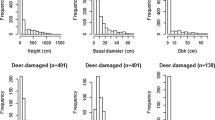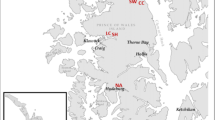Summary
Canada yew (Taxus canadensis) populations currently browsed by white-tailed deer (Odocoileus virginianus) or browsed by deer in the past had significantly lower production of male strobili, female strobili, and seeds than unbrowsed yew populations. Exclosure studies showed that protected yews produced significantly more male and female strobili than unprotected yews, but only after several years of protection. Seed production did not respond as readily to protection from deer perhaps because of reduced pollination levels in browsed yew populations. Previously unbrowsed yews were clipped at different levels of removal of available browse (control (no removal), 25%, 50%, 75%, and 100% removal) to simulate deer browsing. Reduction in male strobilus production was linearly related to clipping intensity in three years of observation. Female strobilus production was significantly reduced only at the 100% level of removal. Intermediate levels of clipping may have even stimulated production of female strobili. Analysis of covariance, with previous year's branch production as the covariate, showed no significant effect of clipping on male strobilus production except in the 100% removal group. Female strobilus production showed no such covariance with branch production. Effects of clipping on seed production could not be reliably assessed in 1984 and 1985 due to low seed production. Seed production in 1986 was significantly reduced only in the 100% removal group. Field observations of deer browsing of Canada yew indicate that 100% levels of removal are typical of natural levels of browsing.
Similar content being viewed by others
References
Aldous SE (1952) Deer browse clipping study in the Lake States Region. J Wildl Manage 16:401–409
Allison TD (1987) The reproductive biology of Canada yew (Taxus canadensis Marsh.) and its modification by herbivory. PhD thesis, University of Minnesota, Minneapolis MN USA
Allison TD (1990) Pollen production and plant density affects pollination and seed production in Taxus canadensis. Ecology 71:516–522
Anderson RC, Loucks OL (1979) White-tail deer (Odocoileus virginianus) influence on structure and composition of Tsuga canadensis forests. J Appl Ecol 16:855–861
Beals EW, Cottam G, Vogl RJ (1960) Influence of deer on vegetation of the Apostle Islands, Wisconsin. J Wildl Manage 24:68–80
BranderRB (1983) Environmental assessment: Natural resources inventory and management Apostle Islands National Lakeshore, Wisconsin. Apostle Islands National Lakeshore, Department of Interior, Wisconsin, USA unpublished report
Braun EL (1950) Deciduous forests of eastern North America. Hafner Press, New York NY USA
Chapin FS III (1980) The mineral nutrition of wild plants. Ann Rev Ecol Syst 11:233–260
Curtis JT (1959) The vegetation of Wisconsin. University of Wisconsin Press, Madison
De Boer SG (1947) The damage to forest reproduction survey. Wis Cons Bull 12:1–23
Dupler AW (1920) Ovuliferous structures of Taxus canadensis. Bot Gaz 69:492–520
Edwards J (1985) Effects of herbivory by moose on flower and fruit production of Aralia nudicaulis. J Ecology 73:861–868
Graham SA (1958) Results of deer exclosure experiments in the Ottawa National Forest. Trans N Am Wildl Conf 23:478–490
Hendrix SD (1979) Compensatory reproduction in a biennial herb following insect defloration. Oecologia 42:107–118
Hendrix SD, Trapp EJ (1981) Plant-herbivore interactions: insect induced changes in host plant sex expression and fecundity. Oecologia 49:119–122
Hull CH, Nie NH (1981) SPSS update 7–9. McGraw-Hill, New York, NY USA
Katsma DE, Rusch DH (1980) Effects of simulated deer browsing on branches of apple trees. J Wildl Manage 44:603–612
King DR (1975) Estimation of yew and cedar availability and utilization. J Wildl Manage 39:101–107
Kozlowski TT, Keller T (1966) Food relations of woody plants. Bot Rev 32:293–382
Krefting LW, Stoeckeler JH (1953) Effect of stimulated snowshoe hare and deer damage on planted conifers in the Lake States. J Wildl Manage 17:487–494
Marquis DA (1974) The impact of deer browsing on Allegheny hardwood regeneration. USDA For Ser Res Paper NE-308
Martell AM (1974) Canada Yew. In: Gill JD, Healy WM (eds) Shrubs and vines for northeastern wildlife, USDA Forest Serv Gen Tech Rep NE-9, pp 158–160
McNaughton SJ (1983) Compensatory plant growth as a response to herbivory. Oikos 40:329–336
Paige KN, Whitham TG (1987) Overcompensation in response to mammalian herbivory: the advantage of being eaten. Am Nat 129:407–416
Ross BA, Bray JR, Marshall WH (1970) Effects of long-term deer exclusion on a Pinus resinosa forest in north-central Minesota. Ecology 51:1088–1093
Snedecor GW, Cochrane WG (1967) Statistical methods, 3rd edition, Iowa State University Press, Ames IA USA
Sokal RR, Rohlf FJ (1981) Biometry, 2nd edition, W.H. Freeman and Co., San Francisco CA USA
Spiker CJ (1935) Some late winter and early spring observations on the white-tailed deer of the Adirondacks. Roosevelt Wildlife Bull. 6:327–385
Stearns FW (1951) The composition of the sugar maple-hemlock-yellow birch association of northern Wisconsin. Ecology 32:245–265
Winer BJ (1971) Statistical principles in experimental design, 2nd edition, McGraw-Hill, New York NY USA
Author information
Authors and Affiliations
Rights and permissions
About this article
Cite this article
Allison, T.D. The influence of deer browsing on the reproductive biology of Canada yew (Taxus canadensis marsh.). Oecologia 83, 523–529 (1990). https://doi.org/10.1007/BF00317204
Received:
Accepted:
Issue Date:
DOI: https://doi.org/10.1007/BF00317204




